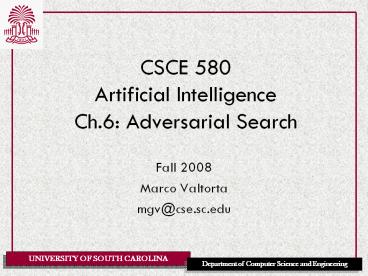CSCE 580 Artificial Intelligence Ch.6: Adversarial Search - PowerPoint PPT Presentation
Title:
CSCE 580 Artificial Intelligence Ch.6: Adversarial Search
Description:
E.g., 2-ply (=1-move) game: UNIVERSITY OF SOUTH CAROLINA ... 4-ply lookahead is a hopeless chess player! 4-ply human novice. 8-ply typical PC, human master. 12 ... – PowerPoint PPT presentation
Number of Views:615
Avg rating:3.0/5.0
Title: CSCE 580 Artificial Intelligence Ch.6: Adversarial Search
1
CSCE 580Artificial IntelligenceCh.6
Adversarial Search
- Fall 2008
- Marco Valtorta
- mgv_at_cse.sc.edu
2
Acknowledgment
- The slides are based on the textbook AIMA and
other sources, including other fine textbooks and
the accompanying slide sets - The other textbooks I considered are
- David Poole, Alan Mackworth, and Randy Goebel.
Computational Intelligence A Logical Approach.
Oxford, 1998 - A second edition (by Poole and Mackworth) is
under development. Dr. Poole allowed us to use a
draft of it in this course - Ivan Bratko. Prolog Programming for Artificial
Intelligence, Third Edition. Addison-Wesley,
2001 - The fourth edition is under development
- George F. Luger. Artificial Intelligence
Structures and Strategies for Complex Problem
Solving, Sixth Edition. Addison-Welsey, 2009
3
Outline
- Optimal decisions
- a-ß pruning
- Imperfect, real-time decisions
4
Games vs. search problems
- "Unpredictable" opponent ? specifying a move for
every possible opponent reply - Time limits ? unlikely to find goal, must
approximate
5
Game tree (2-player, deterministic, turns)
6
Minimax
- Perfect play for deterministic games
- Idea choose move to position with highest
minimax value best achievable payoff against
optimal play - E.g., 2-ply (1-move) game
7
Minimax algorithm
8
Properties of minimax
- Complete? Yes (if tree is finite)
- Optimal? Yes (against an optimal opponent)
- Time complexity? O(bm)
- Space complexity? O(bm) (depth-first exploration)
- (O(m) if successors are generated
one-at-a-time, as in backtracking) - For chess, b 35, m 100 for reasonable
games? exact solution completely infeasible
9
a-ß pruning example
10
a-ß pruning example
11
a-ß pruning example
12
a-ß pruning example
13
a-ß pruning example
14
Alpha-Beta Example Using Intervals
Do DF-search until first leaf
Range of possible values
-8,8
-8, 8
15
Alpha-Beta Example (continued)
-8,8
-8,3
16
Alpha-Beta Example (continued)
-8,8
-8,3
17
Alpha-Beta Example (continued)
3,8
3,3
18
Alpha-Beta Example (continued)
3,8
This node is worse for MAX
-8,2
3,3
19
Alpha-Beta Example (continued)
,
3,14
-8,2
3,3
-8,14
20
Alpha-Beta Example (continued)
,
3,5
-8,2
3,3
-8,5
21
Alpha-Beta Example (continued)
3,3
2,2
-8,2
3,3
22
Alpha-Beta Example (continued)
3,3
2,2
-8,2
3,3
23
Properties of a-ß
- Pruning does not affect final result
- Good move ordering improves effectiveness of
pruning - With "perfect ordering," time complexity
O(bm/2) - ? doubles depth of search
- A simple example of the value of reasoning about
which computations are relevant (a form of
metareasoning)
24
Why is it called a-ß?
- a is the value of the best (i.e., highest-value)
choice found so far at any choice point along the
path for max - If v is worse than a, max will avoid it
- ? prune that branch
- Define ß similarly for min
25
The a-ß algorithm
26
The a-ß algorithm
27
Resource limits
- Suppose we have 100 secs, explore 104 nodes/sec?
106 nodes per move - Standard approach
- cutoff test
- e.g., depth limit (perhaps add quiescence search)
- evaluation function
- estimated desirability of position
28
Evaluation functions
- For chess, typically linear weighted sum of
features - Eval(s) w1 f1(s) w2 f2(s) wn fn(s)
- e.g., w1 9 with
- f1(s) (number of white queens) (number of
black queens), etc.
29
Cutting off search
- MinimaxCutoff is identical to MinimaxValue except
- Terminal? is replaced by Cutoff?
- Utility is replaced by Eval
- Does it work in practice?
- bm 106, b35 ? m4
- 4-ply lookahead is a hopeless chess player!
- 4-ply human novice
- 8-ply typical PC, human master
- 12-ply Deep Blue, Kasparov
30
Deterministic games in practice
- Checkers Chinook ended 40-year-reign of human
world champion Marion Tinsley in 1994. Used a
precomputed endgame database defining perfect
play for all positions involving 8 or fewer
pieces on the board, a total of 444 billion
positions - Jonathan Schaeffer at the department of CS of the
University of Alberta showed that checkers is a
forced draw perfect players cannot defeat each
other (http//www.cs.ualberta.ca/chinook/) - Chess Deep Blue defeated human world champion
Garry Kasparov in a six-game match in 1997. Deep
Blue searches 200 million positions per second,
uses very sophisticated evaluation, and
undisclosed methods for extending some lines of
search up to 40 ply - Othello human champions refuse to compete
against computers, who are too good - Go human champions refuse to compete against
computers, who are too bad. In go, b gt 300, so
most programs use pattern knowledge bases to
suggest plausible moves
31
Summary
- Games are fun to work on!
- They illustrate several important points about AI
- perfection is unattainable ? must approximate
- good idea to think about what to think about













![ARTIFICIAL INTELLIGENCE [INTELLIGENT AGENTS PARADIGM] PowerPoint PPT Presentation](https://s3.amazonaws.com/images.powershow.com/8134330.th0.jpg?_=20160919108)

















